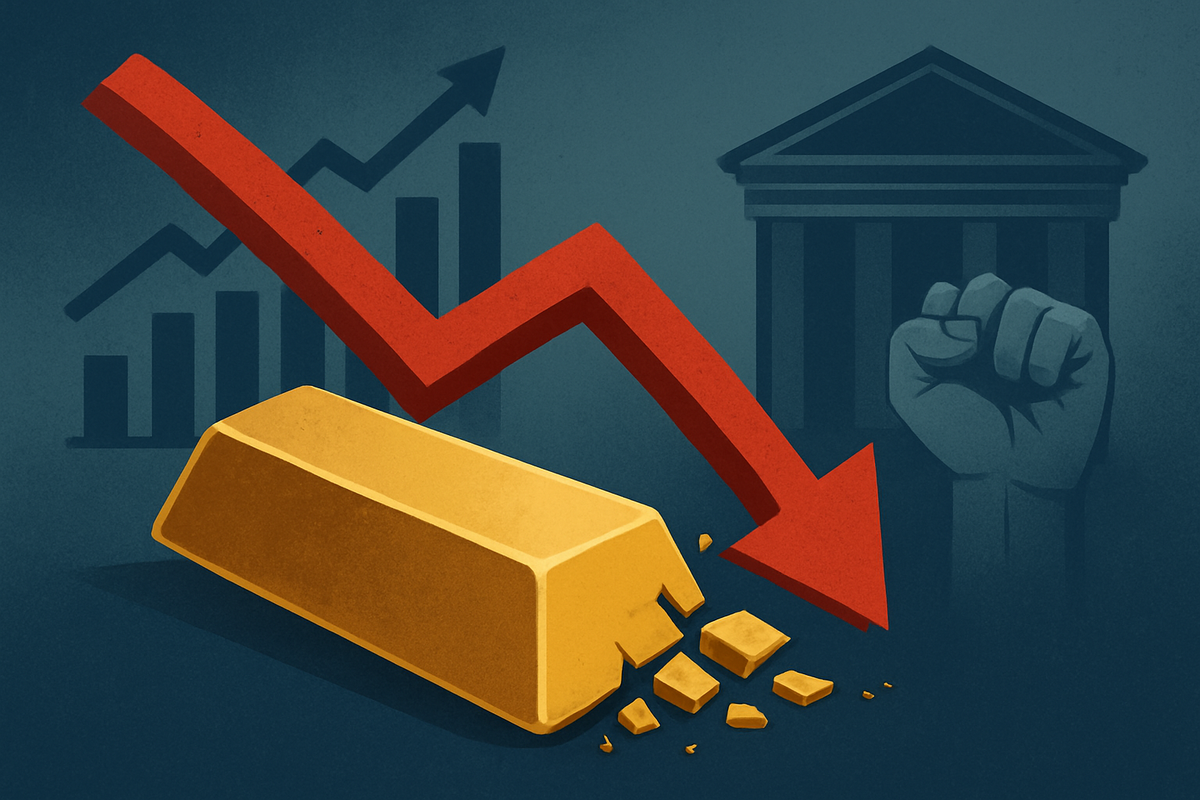
Gold (XAU/USD) prices have experienced a significant downturn, plummeting to $4,025 amidst a confluence of strong U.S. jobs data and hawkish statements from the Federal Reserve. This sharp decline signals a notable recalibration within the precious metals market, as investors digest macroeconomic indicators that suggest a prolonged period of higher interest rates and a robust U.S. economy. The immediate implication is a diminished appeal for non-yielding assets like gold, with capital likely flowing towards higher-yielding alternatives and a strengthening U.S. dollar.
This sudden shift reflects a profound change in investor sentiment, as the prospect of imminent interest rate cuts by the Federal Reserve appears to have receded. The market's reaction underscores gold's inherent sensitivity to monetary policy expectations and the broader economic outlook, challenging its traditional role as a safe-haven asset in an environment of perceived economic strength and tightening financial conditions.
Gold's Steep Descent: A Reaction to Economic Resilience and Fed Resolve
The recent drop in gold prices to $4,025 is a direct consequence of two potent macroeconomic forces: unexpectedly strong U.S. jobs data and the release of hawkish minutes from the Federal Reserve's latest meeting. The U.S. labor market has demonstrated remarkable resilience, with recent reports indicating robust job creation and declining unemployment rates. This strength in the jobs sector suggests that the U.S. economy may be better positioned to withstand higher interest rates than previously anticipated, thereby reducing the urgency for the Federal Reserve to implement rate cuts.
Compounding this sentiment, the minutes from the Federal Open Market Committee (FOMC) meeting revealed a more aggressive stance on monetary policy than some investors had hoped. The minutes indicated a collective resolve among Fed officials to combat inflation, with a clear emphasis on maintaining restrictive policy for longer, and even a willingness to consider further rate hikes if inflationary pressures persist. This hawkish tone effectively dampened any lingering hopes for imminent rate cuts, which had previously provided a supportive backdrop for gold prices.
The timeline leading up to this moment saw gold prices trading with a degree of volatility, often reacting to geopolitical tensions and inflation concerns throughout 2025. However, the recent strong economic data, particularly in the labor market, began to shift the narrative towards economic strength rather than fragility. The subsequent release of the Fed minutes solidified this new outlook, acting as a catalyst for the sharp sell-off in gold. Key players involved are primarily the Federal Reserve, whose monetary policy dictates the cost of borrowing and the attractiveness of alternative investments, and the U.S. labor market, whose performance serves as a critical barometer of economic health. Initial market reactions have been swift, with a notable increase in selling pressure on gold and a corresponding strengthening of the U.S. dollar, as investors adjusted their portfolios to reflect the new interest rate outlook.
Market Repercussions: Winners and Losers in a Hawkish Environment
The significant drop in gold prices, driven by strong economic data and a hawkish Federal Reserve, is set to create distinct winners and losers across various sectors of the financial market. Companies directly involved in gold mining will likely face immediate headwinds, while sectors that benefit from a stronger economy and higher interest rates could see gains.
Gold mining companies, such as Barrick Gold (NYSE: GOLD) and Newmont Corporation (NYSE: NEM), are among the most exposed to declining gold prices. A sustained drop in the value of gold directly impacts their revenue and profitability, potentially leading to reduced exploration budgets, delayed project developments, and downward revisions to earnings forecasts. Investors in these companies may experience a contraction in share prices as the market re-evaluates their future earnings potential in a lower gold price environment. Furthermore, companies that provide services or equipment to the gold mining industry could also feel a ripple effect, albeit indirectly.
Conversely, sectors sensitive to economic growth and higher interest rates could stand to benefit. Financial institutions, particularly banks like JPMorgan Chase (NYSE: JPM) and Bank of America (NYSE: BAC), often thrive in environments with higher interest rates, as it allows them to earn a larger margin on their lending activities. A robust U.S. economy, as indicated by strong jobs data, also bodes well for loan demand and overall financial activity. Additionally, companies in cyclical sectors, such as industrials and consumer discretionary, which are highly sensitive to economic cycles, may see improved prospects as consumer spending and business investment are bolstered by a healthy labor market. The strengthening U.S. dollar, a byproduct of hawkish Fed policy, could also benefit U.S. importers by making foreign goods cheaper, though it could pose challenges for U.S. exporters by making their products more expensive abroad.
The shift in investor sentiment away from safe-haven assets like gold towards riskier, growth-oriented investments could also benefit equity markets in general, particularly large-cap technology companies that have demonstrated strong earnings growth. However, this benefit might be tempered by concerns that higher interest rates could eventually weigh on corporate borrowing costs and valuations. Overall, the current macroeconomic environment favors companies that can leverage economic strength and adapt to a higher interest rate regime, while posing challenges for those whose fortunes are closely tied to the price of precious metals.
Broader Implications: Reshaping Market Dynamics and Investment Strategies
The recent plunge in gold prices, triggered by robust U.S. jobs data and a resolute Federal Reserve, carries wider significance, potentially reshaping market dynamics and influencing long-term investment strategies. This event underscores a broader industry trend where traditional safe-haven assets are increasingly sensitive to the interplay of economic fundamentals and monetary policy, rather than solely geopolitical risks or inflation fears.
This development fits into a narrative of evolving market expectations regarding inflation and economic growth. For much of 2025, inflation remained a key concern, driving some investors towards gold as a hedge. However, the Fed's hawkish stance signals its commitment to taming inflation, while strong jobs data suggests a "soft landing" or even sustained growth, diminishing gold's appeal as both an inflation hedge and a safe haven. This challenges the prevailing wisdom that gold is an automatic beneficiary during times of economic uncertainty or rising prices.
The ripple effects extend beyond the precious metals market. Competitors in the investment landscape, particularly those offering interest-bearing assets like government bonds, become more attractive. The yield on U.S. Treasuries, for instance, would likely rise in response to hawkish Fed minutes, drawing capital away from non-yielding gold. This could also impact other commodity markets, as a stronger U.S. dollar generally makes dollar-denominated commodities more expensive for international buyers, potentially exerting downward pressure across the board. Regulatory or policy implications are primarily centered around the Federal Reserve's mandate to maintain price stability and maximum employment. This event reaffirms the Fed's independence and its willingness to act decisively based on economic data, even if it means prolonged periods of higher interest rates.
Historically, periods of strong economic growth and rising interest rates have often correlated with weaker gold performance. For example, during certain phases of the 1980s and 1990s, when the U.S. economy experienced robust expansion and the Fed maintained a firm grip on inflation, gold struggled. This current scenario bears some resemblance, suggesting that if the U.S. economy continues its strong trajectory and the Fed remains hawkish, gold could face sustained pressure. However, it's crucial to note that gold's role as a hedge against extreme tail risks or systemic financial crises remains, and any future resurgence in such risks could quickly reverse its fortunes.
What Comes Next: Navigating a New Market Landscape
Looking ahead, the trajectory of gold prices and the broader financial markets will largely hinge on the continued interplay between U.S. economic data and the Federal Reserve's monetary policy decisions. In the short term, gold (XAU/USD) is likely to remain under pressure as long as the U.S. labor market demonstrates strength and the Fed maintains its hawkish rhetoric, dampening any immediate hopes for rate cuts. Investors may continue to reallocate capital from gold to higher-yielding assets, leading to further downside risk or consolidation around current levels.
In the long term, the outlook for gold will depend on several key factors. Should the U.S. economy eventually show signs of cooling, or if inflation proves more persistent than the Fed anticipates, the narrative could shift again, potentially rekindling gold's appeal as an inflation hedge or safe haven. Geopolitical events, which can quickly trigger demand for safe assets regardless of interest rate expectations, also remain a wild card. Potential strategic pivots for investors include a greater emphasis on diversification beyond traditional hedges, focusing on assets that can perform well in a higher interest rate environment, or those with strong fundamental growth stories.
Market opportunities may emerge for contrarian investors who believe the current gold sell-off is overdone, particularly if future economic data suggests a different path for the Fed. However, the immediate challenge for gold bugs will be navigating a market where the opportunity cost of holding non-yielding assets is elevated. Potential scenarios range from gold entering a prolonged bear market if the "higher for longer" interest rate environment persists and the economy remains robust, to a swift rebound if unexpected economic weakness or a significant geopolitical crisis materializes. Adaptations required from market participants include a more nuanced understanding of gold's drivers, moving beyond simplistic assumptions about its safe-haven status, and integrating monetary policy expectations more deeply into their investment models.
Comprehensive Wrap-up: Gold's Evolving Role in a Dynamic Market
The recent drop in gold prices to $4,025 marks a pivotal moment, underscoring the precious metal's evolving role within a dynamic global financial landscape. The key takeaway is the profound influence of macroeconomic fundamentals—specifically, strong U.S. jobs data and a hawkish Federal Reserve—on asset valuations. This event vividly illustrates that in an environment of perceived economic strength and a central bank committed to restrictive monetary policy, the opportunity cost of holding non-yielding gold becomes significantly higher, leading investors to favor assets that offer a yield or greater growth potential.
Moving forward, the market will likely be characterized by a continued focus on economic indicators, particularly inflation figures and labor market reports, which will guide the Federal Reserve's future policy decisions. The "higher for longer" interest rate narrative, if sustained, will likely keep gold under pressure, challenging its traditional safe-haven appeal. However, it's crucial not to dismiss gold entirely; its intrinsic value as a hedge against extreme tail risks, currency debasement, or unforeseen geopolitical shocks remains, albeit potentially overshadowed in the current climate.
Investors should watch closely for any shifts in the Federal Reserve's tone, significant changes in inflation expectations, or the emergence of new geopolitical tensions. These factors could quickly alter the trajectory of gold prices. The current environment necessitates a sophisticated approach to portfolio construction, where diversification and a deep understanding of macroeconomic forces are paramount. While gold has faced a setback, its long-term significance in a well-balanced portfolio, particularly during periods of genuine market turmoil, should not be entirely discounted, but its immediate future appears tied to the Fed's resolute stance and the resilience of the U.S. economy.
This content is intended for informational purposes only and is not financial advice






